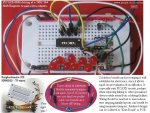louisyuikin
New Member
Hi
I'm new to Picaxe and electronics in general. I have just finished soldering the AXE090 board and it downloads code OK.
Now, how do I ''wire'' the components on the board. On one side there are pins for the mcu and on the other sides markings for components (LDR' SW1, 2,3,...)
Suppose I want to experiment with tutorial no.6 (using analog sensors)...how the I proceed to make the connections...
Could anybody suggest a post in the forum or pages in the manual to get me started. Or maybe a link on the web.
Thanks
LouisY.
I'm new to Picaxe and electronics in general. I have just finished soldering the AXE090 board and it downloads code OK.
Now, how do I ''wire'' the components on the board. On one side there are pins for the mcu and on the other sides markings for components (LDR' SW1, 2,3,...)
Suppose I want to experiment with tutorial no.6 (using analog sensors)...how the I proceed to make the connections...
Could anybody suggest a post in the forum or pages in the manual to get me started. Or maybe a link on the web.
Thanks
LouisY.

